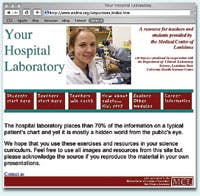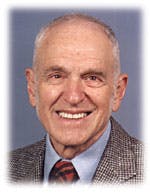The ObservatorySeptember 2003News
Ambassador laboratorians work with teachers. By partnering with middle and high school educators to promote their field, clinical laboratorians have become ambassadors for their profession. Through a joint effort of the Pathology Department at the Medical Center of Louisiana in New Orleans and the Department of Clinical Laboratory Sciences at Louisiana State University Health Sciences Center, they encourage students to join the next generation of laboratory scientists.The collaborative effort to increase the visibility of the profession involves a new Web-based lesson plan for middle and high school students to experience the work of the laboratory scientist. The first version of the website, a grass-roots effort, provides a service that instructors will use and revisit at least twice a year.In its initial offering, the site provides a written lesson plan complete with handouts and examinations to accompany a Web-based simulation of WBC differentials. The student is asked to view a short presentation (which introduces the work performed in the hematology lab), then complete the exercise and discover the patients diagnosis. The pre-test and post-test are designed to measure change in cognitive, as well as affective, learning domains. The website content, which also contains a short presentation on the lab workers risk of on-the-job HIV infection, is designed to change every semester to feature a new laboratory discipline. Future contributions will be supported by a grant from the American Society for Clinical Laboratory Science.A random cash prize drawing is offered as an extra incentive to teachers who submit performance data and proof of participation. Science project ideas, banks of images for use and career information are also included on this website, as are ideas on how educators can link up with local laboratorians. The site is available at:
www.mclno.org/labpartners/index.htm.West Nile Virus cases steadily increase. West Nile Virus (WNV) is making a significant impact in the United States this year. By mid-August, the Centers for Disease Control and Prevention (CDC) announced the number of WNV cases had tripled in one week. The numbers are starting to change very, very quickly, CDC Director Julie Gerberding told reporters in Atlanta. Officials predict WNV will reach every state in the coming months. At the time of Gerberdings press conference, the virus had been diagnosed in 153 people from 16 states, compared to 112 cases in four states in mid-August last year. Colorado had been hardest hit with 111 cases. On August 5, a 67-year-old Boulder woman died only six days after feeling the onset of WNV symptoms, one of several deaths believed to have been caused by the mosquito-borne infection.2002 saw the number of cases of West Nile encephalitis in the United States soar to 4,156 human cases and 284 deaths the largest in the world. Prior to 1999, no cases of WNV had ever been reported in this country. With the encephalitis outbreak that year, there were 62 diagnosed human cases and seven deaths; in 2000, 21 human cases and two deaths; in 2001, 66 and nine.There is no way to prevent the virus from spreading or to predict which areas it will strike the hardest, says Dr. Sue Montgomery of the CDC. The USGS National Wildlife Health Center is working with CDC to learn the current geographic extent of WNV. Its disease scientists, by way of specialized biological containment facilities, provide diagnostic support and research results to public health departments utilizing dead wild birds as sentinels for detecting WNV. Wild-bird mortality is an accurate indicator of the extent of WNV and provides an early warning system for the emergence of the virus in new locations. The three-year study focuses on the probable dissemination of WNV along migratory corridors.The National Institute of Allergy and Infectious Diseases (NIAID) also supports researchers investigating how WNV disseminates throughout the environment via an International Centers for Infectious Disease Research program in Mexico. The research studies whether migrating bird populations carry the virus from its presumed point of entrance into the Western Hemisphere (New York City) to points in Central and South America. Wild birds and chickens in the Yucatan Peninsula are also being examined for evidence of exposure to West Nile Virus. Birds might be year-round reservoirs for the viruses that cause encephalomyelitis and St. Louis encephalitis.Events
www.mclno.org/labpartners/index.htm.West Nile Virus cases steadily increase. West Nile Virus (WNV) is making a significant impact in the United States this year. By mid-August, the Centers for Disease Control and Prevention (CDC) announced the number of WNV cases had tripled in one week. The numbers are starting to change very, very quickly, CDC Director Julie Gerberding told reporters in Atlanta. Officials predict WNV will reach every state in the coming months. At the time of Gerberdings press conference, the virus had been diagnosed in 153 people from 16 states, compared to 112 cases in four states in mid-August last year. Colorado had been hardest hit with 111 cases. On August 5, a 67-year-old Boulder woman died only six days after feeling the onset of WNV symptoms, one of several deaths believed to have been caused by the mosquito-borne infection.2002 saw the number of cases of West Nile encephalitis in the United States soar to 4,156 human cases and 284 deaths the largest in the world. Prior to 1999, no cases of WNV had ever been reported in this country. With the encephalitis outbreak that year, there were 62 diagnosed human cases and seven deaths; in 2000, 21 human cases and two deaths; in 2001, 66 and nine.There is no way to prevent the virus from spreading or to predict which areas it will strike the hardest, says Dr. Sue Montgomery of the CDC. The USGS National Wildlife Health Center is working with CDC to learn the current geographic extent of WNV. Its disease scientists, by way of specialized biological containment facilities, provide diagnostic support and research results to public health departments utilizing dead wild birds as sentinels for detecting WNV. Wild-bird mortality is an accurate indicator of the extent of WNV and provides an early warning system for the emergence of the virus in new locations. The three-year study focuses on the probable dissemination of WNV along migratory corridors.The National Institute of Allergy and Infectious Diseases (NIAID) also supports researchers investigating how WNV disseminates throughout the environment via an International Centers for Infectious Disease Research program in Mexico. The research studies whether migrating bird populations carry the virus from its presumed point of entrance into the Western Hemisphere (New York City) to points in Central and South America. Wild birds and chickens in the Yucatan Peninsula are also being examined for evidence of exposure to West Nile Virus. Birds might be year-round reservoirs for the viruses that cause encephalomyelitis and St. Louis encephalitis.Events
Baer to receive ASCP award. On September 19, 2003, in New Orleans, MLOs editorial advisory board member and Tips editor, Daniel M. Baer, MD, FASCP, will receive the Ward Burdick Award for Distinguished Service to Clinical Pathology at the American Society for Clinical Pathologists (ASCP) annual meeting, Pathology Today. For 75 years, this award has recognized an ASCP member who has made a significant contribution to pathology through sustained service to the profession and to the Society. Dr. Baer has been an active ASCP contributor throughout his exceptional career, presenting workshops at nearly every national Society meeting from 1965 until his retirement in 1997.It's
showtime 2003!Oct. 8-11Washington G-2 Reports Lab Institute 2003 Arlington, VAwww.g2reports.comOct. 19-2221st Annual International Symposium on Laboratory Automation and Robotics Boston, MAwww.islar.comOct. 22-25COLAs 18th POL Symposium Baltimore, MDwww.cola.orgOct. 29-Nov. 1AACCs 18th Annual San Diego Conference on Molecular and Genetic Technologies Baltimore, MDwww.aacc.org/meetings/sandiego/2003© 2003 Nelson Publishing, Inc. All rights reserved.
showtime 2003!Oct. 8-11Washington G-2 Reports Lab Institute 2003 Arlington, VAwww.g2reports.comOct. 19-2221st Annual International Symposium on Laboratory Automation and Robotics Boston, MAwww.islar.comOct. 22-25COLAs 18th POL Symposium Baltimore, MDwww.cola.orgOct. 29-Nov. 1AACCs 18th Annual San Diego Conference on Molecular and Genetic Technologies Baltimore, MDwww.aacc.org/meetings/sandiego/2003© 2003 Nelson Publishing, Inc. All rights reserved.
About the Author
Sign up for our eNewsletters
Get the latest news and updates



